Trump’s presidency is failing rapidly. Like others before him, modern American presidents fail when they cannot master or comprehend the government that they inherit. This is a hard concept to grasp in an age when non-stop media coverage leads us to focus on the president’s communication skills and when presidents themselves value spin more than expertise. But in the end presidential failure is about reality, not words—no matter how lofty and inspiring or how crude and insulting.
Contemporary presidents are especially prone to mistaking spin for reality for several reasons. First of all, they are nominated not by other elected officials who have some sense of what it takes to govern, but by activists and party electorates who value inspiration and entertainment. Second, the importance of mass communication leads presidents to believe that the words and activities that got them into office can work once they are in office: more rallies, more speeches, more tweets, and more television advertising.
Nothing can be further from the truth.
Presidential scholars have been aware of the disjuncture between campaigning and governing for some time now. More than a decade ago, Sam Kernell wrote a book called Going Public: New Strategies of Presidential Leadership (CQ Press, 2007), in which he showed that beginning with President Kennedy, modern presidents spent a great deal more time on minor presidential addresses and on domestic and international travel than their predecessors. All this communication, he argued, came at the expense of actual governing. Later on another presidential scholar, George C. Edwards III, writing in Overreach, Leadership in the Obama Presidency (Princeton University Press, 2012) argued that Obama thought he could go directly to the public to get support for his programs, an approach that placed communication over negotiation and that resulted in a stunning midterm loss for his party.
Reality still matters, and spin has its limits—even in an era of social media.
As long as things are going okay for most people, Americans tolerate a president’s verbal gymnastics. But when people are in trouble, even the most ardent government haters ask that famous question: “Where’s the government?” And for most Americans, the president is the government. Following the botched federal response to Hurricane Katrina in 2005, the collateral damage to the presidency of George W. Bush was extensive. His popularity never recovered and his second-term agenda, including bold changes to Social Security, was destroyed. Nearly a decade later when President Obama rolled out his signature achievement, the Affordable Care Act, the hugely embarrassing crashing of the computer systems meant to implement the act increased Republican opposition to it and undermined public confidence in the government’s ability to implement important executive actions.
Trump’s failures during the coronavirus pandemic run the gamut from the rhetorical to the organizational. Every time the president speaks he seems to add to the fear and chaos surrounding the situation: telling Americans it was not serious by asserting his “hunches” about data, assuring people that everyone would be tested even when there were very few tests available, telling people that we are very close to a vaccine when it is anywhere from 12 to 18 months away, mistakenly asserting that goods as well as people from Europe would be forbidden from entering the United States, and announcing that Google had a website for testing while the initiative was merely an unimplemented idea, were just a few of his televised gaffes. After every presidential statement, “clarifications” were needed. Trump has the unique distinction of giving a national address meant to calm the country that had the effect of taking the stock market down over 1,000 points.
We have come to expect verbal imprecision and outright lies from this president, but that is more easily corrected on less momentous developments. When there is fundamental incompetence on matters of tremendous importance, voters punish poor results. And this is where Trump’s actions on the coronavirus have gone far off target. One of the most glaring deficiencies of his administration has been the failure to have enough tests available to identify those infected and to screen others for possible exposure. South Korea, a country a fraction of the size of the United States, is testing thousands more people a day than the United States. The failure to produce tests quickly will go down as one of the biggest failures in the overall handling of this disease because it prevented authorities from understanding the scope of the pandemic and therefore made it difficult for them to undertake appropriate steps to mitigate its spread. Other countries had tests and now state governments are rapidly rolling out their own tests after the CDC belatedly removed regulatory barriers. Even the nation’s chief infectious disease doctor, Anthony Fauci, has admitted that testing is a major failure—a statement that is most certainly not one of the president’s talking points.
In this and other areas, Trump has failed to learn from the failures of his predecessors. When President Ronald Reagan signed into law the fundamental restructuring of the military known as the Goldwater-Nichols reforms,[1] he did this knowing that he did not want a military fiasco on his watch like the failed Iranian rescue mission that did in Jimmy Carter’s presidency. And following the total breakdown in the Federal Emergency Management Agency’s handling of Hurricane Katrina, President Barack Obama made sure his FEMA director was an experienced state emergency management director. He knew that poor performance during natural disasters would doom his presidency.
During the Obama Administration, the White House dealt with a precursor of the coronavirus: the Ebola virus. While the scrambling eventually worked out thanks to decisive executive office leadership, it illustrated that pandemics were a fundamental national security threat. They created the Global Health Security Team in the National Security Council to prepare. In May of 2018, Trump disbanded the team allegedly because he never thought pandemics would happen and because “I’m a business person. I don’t like having thousands of people around when you don’t need them.” Trump’s hurried justification for abandoning a unit (that was well short of thousands) showed Trump’s limited understanding of why government is different from business—it is in the business of preparing for low-probability events. For instance, the United States military spends billions every year preparing for wars all over the globe and even in outer space that may never take place. The art of presidential leadership is anticipating major problems and coming up with plans to mitigate them.
In addition to learning from past administrations, presidents need the ability to anticipate reactions to their actions. The Trump administration has been especially inept on this dimension from the beginning. The first big executive order he issued, largely banning Muslims from coming to America, was so ill-conceived that chaos broke out in airports around the world as people with green cards to work in America and Muslims who had assisted U.S. military forces in Iraq were initially turned away. Airport chaos seems to be a specialty of the Trump administration. It reappeared this past weekend, as Americans came home from Europe in huge numbers following Trump’s announcement to close off travelers from Europe and screen returning Americans. When travelers arrived, they found vastly inadequate staffing at airports and were thus forced into the very situation medical authorities were warning against: large crowds being hoarded into small spaces with constant, close contact.
Trump has also failed to fill top government positions and turnover is far higher than in any other recent administration, as Katherine Tenpas has tracked on these pages. The absence of expertise in top government jobs is especially dangerous during emergencies. Also, when positions are filled they have not necessarily gone to the strongest candidates. Take for instance leadership at the Centers for Disease Control and Prevention, the nation’s top agency for infectious diseases. Dr. Robert Redfield’s appointment was opposed by the Center for Science in the Public Interest which warned the administration that Redfield lacked a public health background and that he was under investigation for scientific misconduct.
Modern presidents inherit an enormous enterprise called the federal government that employs about the same number of people as the 6 largest U.S. companies and has a combined annual revenue that is larger than the combined revenues of the top 16 companies in the Fortune 500.[2] No wonder modern presidents have had trouble managing this enterprise—in an organization this big, something is always going right and something is always going wrong. A president who understands what’s going right can call on deep wells of expertise to protect himself from the failures that will inevitably be attributed to him. And on the flip side, a president who is aware of what’s going wrong can take corrective actions and try to stave off the kinds of bureaucratic meltdowns that will also be attributed to him.
As Oval Office leadership fails while the pandemic spreads, governors, mayors, university presidents, religious leaders, business executives, and health providers are stepping into the leadership vacuum that has been the Trump presidency. They have sent workers home to telework, announced their own social distancing rules, and developed their steps to limit the spread of the pandemic. This tragedy teaches us many things about preparedness and public health, but it also warns us about the dangers of presidents who are manifestly unprepared to govern.
[1] These were named after Senator Barry Goldwater (R-Ariz.) and Congressman William Nichols (D-Ala.) and established a new era of joint activity and preparation among the branches of the United States military.
[2] Elaine C. Kamarck, Why Presidents Fail and How they Can Succeed Again, Brookings Institution Press, 2016, page 123.
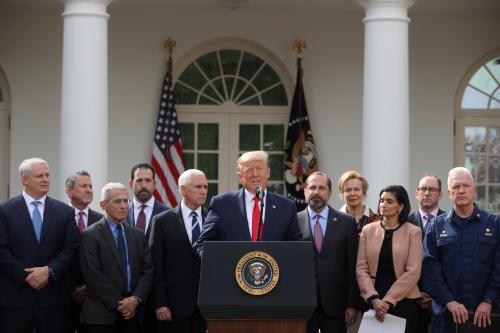
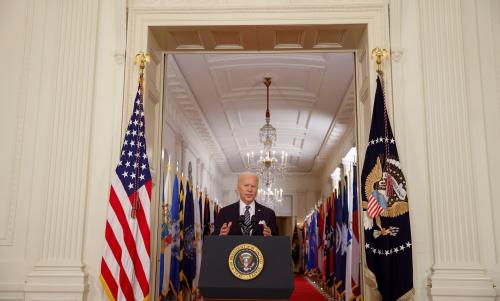
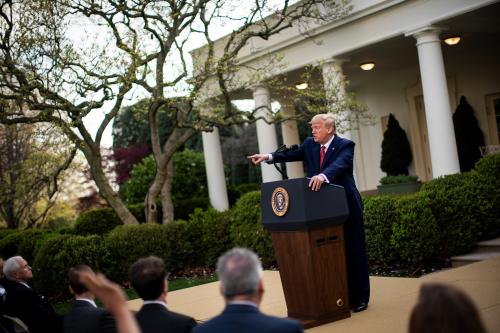


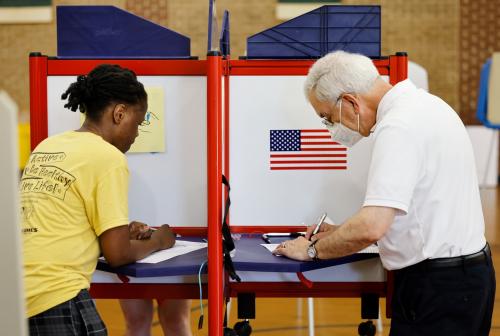

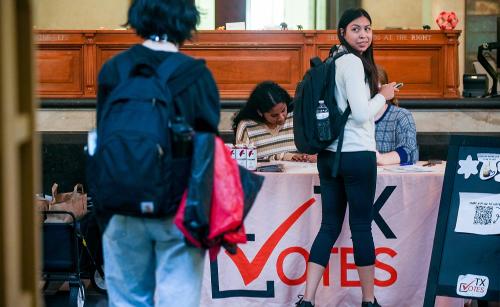
Commentary
Trump’s failed presidency
March 16, 2020